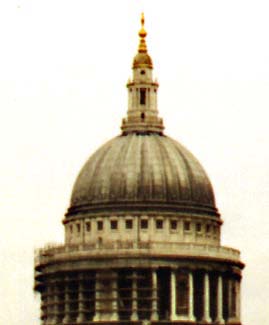|
Rebuilder of London
A large area of London
was damaged by fire between September 2 and September 6, 1666. The fire started accidentally at Farriner's Bakery
in Pudding Lane and destroyed 13,200 houses and 87 churches at a cost of 10% of the entire wealth of England at
the time.
Christopher Wren's involvement with the subsequent rebuilding of London are isl known and documented but not so
much the extraordinary involvement of his friend and associate - Robert Hooke!
Hooke was appointed as one of three surveyors to oversee the repairs and constructions - a task he went about with
great determination and thoroughness. His output was extraordinary and probably equal to the work of the other
two surveyors combined.
He designed many of the new buildings and contributed directly to their improved architecture and increased functionality.
Several of his works are still incorrectly credited to Christopher Wren.
The dome of St. Paul's Cathedral dominates London's skyline from the river.

Christopher Wren probably took notice
of Hooke's advice when designing St.Paul's for its dome is double-vaulted as suggested to him by Robert Hooke.
These two giants of the 17th century had much in common. Ideas and recommendations for building design would have
been exchanged freely between them.
 One
cannot help wondering therefore about the features of the Whispering Gallery - an area lining the inner-dome which amplifies sound. One
cannot help wondering therefore about the features of the Whispering Gallery - an area lining the inner-dome which amplifies sound.
Hooke was quite conversant with the properties of sound and had already experimented with sound-amplification through
the use of shape and structure. He understood sound was made up of beats of air and had already invented an ear
trumpet to assist hearing. He knew also that sound could travel along a wire (mechanically).
He designed the main room at Montague House (one of many buildings he designed and built) in a certain proportion
so that a whisper uttered at a wall one side would be heard at the other!
Maybe when we whisper in the dome of St. Paul's, the past is whispering back to us, within those faint air waves
is another secret yet to be proven regarding Hooke's work and influence in the 17th century?
The Monument was designed and built (building work over-seen) by Hooke, as were: Montague House, Burlington House
and Bethlam Hospital for the mentally ill, and The Royal College of Physicians. He also designed or influenced
the construction of many buildings and churches - notably the spire of St. Mary's-le-bow which employed his ideas
of using catenary curves.
His design and construction of Bethlam Hospital involved many innovations to make the building an aid to the healing
process of the mentally ill. The building took 2 years to complete, occupying an area of 43,200 square feet and
being 40 feet deep. The windows of rooms holding patients were unglazed, affording fresh air to the sick. There
were separate toilets for men and women, hydrotheraputic baths, and areas where patients could exercise. Hooke
aimed to help relieve depression. When completed, it was the only building in London to resemble a palace until
Hooke designed and built Montague House!
The Monument was not just a structure to mark the location where the fire began. Hooke designed it with scientific
experimentation in mind. At 202 feet in height, it is the tallest free-standing Doric column in the world, and
was intended to allow barometer readings to be taken at its top. Hooke used the column on 16th May 1668 to carry
out atmospheric pressure readings with his mercury barometer and discovered a mercury drop of approximately a third
of an inch. Hooke also intended to use the column to test his theories concerning the use of pendulum clocks and
the effects of gravity over them when placed at different heights from the earth's centre of gravity. The experiment
was proposed before the Royal Society on 17th December 1681 although there is no record of it being carried out.
As surveyor, Hooke was responsible for issuing certificates on completed foundations. It is recorded he issued
2000 of these - a further testament to his ceaseless energy as he would have inspected the work in each case.
Previous Page | Continue...
|

 One
cannot help wondering therefore about the features of the Whispering Gallery - an area
One
cannot help wondering therefore about the features of the Whispering Gallery - an area